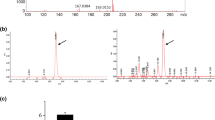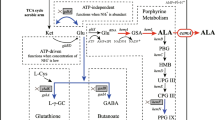Abstract
In this study, we introduced a new strategy, feeding d-glucose, to overproduce extracellular 5-aminolevulinic acid (ALA) in the recombinant Escherichia coli. We investigated that the d-glucose concentration is dependent on extracellular ALA production. The results indicated that increasing d-glucose concentration in bacteria culture enhanced final cell density and ALA yield and simultaneously decreased the activities of ALA synthase (ALAS) and ALA dehydratase (ALAD); then, the inhibitory effect of d-glucose on ALAS activity was relieved with the metabolism of d-glucose. when 4.0 g/L d-glucose was added at late exponential phase; 1.46 g/L ALA was achieved in shaking culture, which is 47% or 109% higher than the ALA yields with 30 mM levulinic acid of ALAD inhibitor or no inhibitor. In jar fermenter, final extracellular ALA concentration reached 3.1 g/L by feeding with d-glucose.







Similar content being viewed by others
References
Beale, S. I., & Weinstein, J. D. (1990). Biosynthesis of heme and chlorophylls, pp. 287–391. New York: McGraw-Hill.
Vladimir, Y. B., Demain, A. L., & Zaitseva, N. I. (1997). Critical Reviews in Biotechnology, 17, 21–37. doi:10.3109/07388559709146605.
Sasikala, C. H., Ramana, V., & Raghuveer, R. P. (1994). Biotechnology Progress, 10, 451–459. doi:10.1021/bp00029a001.
Hotta, Y., & Watanabe, K. (1999). Chemical Regulation of Plants, 34, 85–96.
Chen, H. M., Chen, C. T., Yang, H., Lee, M. I., Kuo, M. Y., Kuo, Y. S., et al. (2005). Journal of Oral Pathology & Medicine, 34, 253–256. doi:10.1111/j.1600-0714.2004.00267.x.
Tobias, J. B., Marius, B., Saulius, B., Zita, K., Wolfgang, B., Ronald, S., et al. (2007). Journal of Photochemistry and Photobiology B, Biology , 87, 174–182. doi:10.1016/j.jphotobiol.2007.03.008.
Jordan, P. M. (1991). Biosynthesis of tetrapyrroles, vol. 19: New comprehensive biochemistry, pp. 1–24. Amsterdam: Elsevier.
Sasaki, K., Ikeda, S., Nishizawa, Y., & Hayashi, M. (1987). Journal of Fermentation Technology, 65, 511–515.
Choi, C., Hong, B. S., Sung, H. C., Lee, H. S., & Kim, J. H. (1999). Biotechnology Letters, 21, 551–554. doi:10.1023/A:1005520007230.
Vemuri, G. N., Eiteman, M. A., & Altman, E. (2002). Journal of Industrial Microbiology & Biotechnology, 28, 325–332. doi:10.1038/sj.jim.7000250.
Lee, D. H., Jun, W. J., Shin, D. H., Cho, H. Y., & Hong, B. S. (2005). Bioscience, Biotechnology, and Biochemistry, 69, 470–476. doi:10.1271/bbb.69.470.
Alan, J. B., Keith, C., David, H., Karl, I., & Karen, S. (2002). Journal of Bacteriology, 184, 1685–1692. doi:10.1128/JB.184.6.1685-1692.2002.
Xie, L., Hall, D., Eiteman, M. A., & Altman, E. (2003). Applied Microbiology and Biotechnology, 63, 267–273. doi:10.1007/s00253-003-1388-2.
Liu, X. X., Lin, J. P., Qin, G., & Cen, P. L. (2005). Chinese Journal of Chemical Engineering, 13, 522–528.
Mauzerall, S., & Granick, S. (1956). Journal of Biological Chemistry, 219, 435–442.
Burnham, B. F. (1970). Methods in Enzymology, 17A, 195–204. doi:10.1016/0076-6879(71)17179-0.
Mitchell, L. W., & Jaffe, E. M. (1993). Archives of Biochemistry and Biophysics, 300, 169–177. doi:10.1006/abbi.1993.1024.
Laemnli, U. K. (1970). Nature, 227, 680–685. doi:10.1038/227680a0.
Qin, G., Lin, J. P., & Liu, X. X. (2006). Journal of Bioscience and Bioengineering, 102, 316–322. doi:10.1263/jbb.102.316.
Chung, S. Y., Seo, K. H., & Rhee, J. I. (2005). Process Biochemistry, 40, 385–394. doi:10.1016/j.procbio.2004.01.024.
Lee, D. H., Jun, W. J., Kim, K. M., Shin, D. H., Cho, H. Y., & Hong, B. S. (2003). Enzyme and Microbial Technology, 32, 27–34. doi:10.1016/S0141-0229(02)00241-7.
Akihiko, A., Hitoshi, F., Katsumi, N., & Yoshinori, N. (2000). Journal of Bioscience and Bioengineering, 89, 176–180. doi:10.1016/S1389-1723(00)88733-2.
Echelard, Y., Dymetryszyn, J., Drolet, M., & Sasarman, A. (1988). Nucleotide sequence of the hemB gene of Escherichia coli K12. Molecular & General Genetics, 214, 503–508. doi:10.1007/BF00330487.
Brownlee, M. (1994). Glycation and diabetic complications. Diabetes, 43, 836–841.
Jain, S., & Palmer, N. (1997). The effects of oxygen radicals metabolites and vitamin E on glycosylation of proteins. Free Radical Biology & Medicine, 22, 593–596. doi:10.1016/S0891-5849(96)00377-2.
Acknowledgments
We gratefully acknowledge Meng, F. J., Ph.D., for revising the manuscript. This study was supported by the Scientific Research Fund of the Zhejiang Provincial Education Department (no. 20070617).
Author information
Authors and Affiliations
Corresponding author
Rights and permissions
About this article
Cite this article
Liu, X.X., Wang, L., Wang, Y.J. et al. d-glucose Enhanced 5-Aminolevulinic Acid Production in Recombinant Escherichia coli Culture. Appl Biochem Biotechnol 160, 822–830 (2010). https://doi.org/10.1007/s12010-009-8608-x
Received:
Accepted:
Published:
Issue Date:
DOI: https://doi.org/10.1007/s12010-009-8608-x




